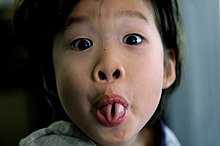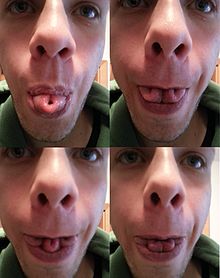Tongue rolls
Under tongue rolling ability of the majority of the human population is understood that tongue rolling tubularly by high curvature of the lateral edges. The proportion of tongue rollers in the population is between 65 and 81%, the proportion of women being slightly higher than that of men.
For a long time, tongue rolling was mistakenly considered an example of dominant inheritance in the Mendelian sense. However, studies in 1940 (Sturtevant) and 1951 (Komai) showed that on the one hand children can develop from "scooters" to "non-scooters" and that on the other hand children can also develop from "non-scooters" into "scooters" . In addition, twin studies by Matlock (1952) showed that even identical twins can have different tongue rolling abilities.
Not all "rollers" master tongue rolling from birth. In studies by Komai (1951), 54 percent of the scooters and non-scooters examined were able to roll their tongues at the age of seven, and a further 22 percent learned to do so by the age of twelve.
Tongue rolling turns out to be a complex acquired property that is determined both by several genes and by environmental influences. A clear assignment of a lineage is not possible by rolling the tongue; in particular, it cannot serve as evidence in an exclusion procedure for a parentage certificate .
Web links
Individual evidence
- ^ John H. McDonald, Karla Boyd, Myths of Human Genetics: Tongue Rolling
- ↑ Sturtevant, AH 1940. A new inherited character in man. Proceedings of the National Academy of Sciences USA 26: 100-102.
- ↑ Komai, T. 1951. Notes on lingual gymnastics. Frequency of tongue rollers and pedigrees of tied tongues in Japan. Journal of Heredity 42: 293-297.
- ↑ Matlock, P. 1952. Identical twins discordant in tongue-rolling. Journal of Heredity 43:24.

